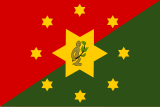We left it to brew on the drip filter system throughout the day until its consitency resembled a weak mud.
Twelve cups a day was the normal ration, little wonder that I had at one stage to resort to sleeping tablets at night as the arabica coursed through my veins.
 |
| Spraying Coffee |
PNG is well known for its coffee and tea production. The latter can be found in large plantations further up the Highway towards Mount Hagen, but the Eastern Highlands with a stable year-round temperature of 26 degrees and a height of 1,600 meters above sea level is ideal for coffee growing.
 |
| Picking Coffee At The Red Cherry tage |
 |
| Kopi Meri |
 |
| Factory Worker |
The conditions inside the factory were dickensian with a lot of dust, poor visibility and poorly shielded industrial equipment.
But at the very least there was employment and a source of income for the villagers who came to work there.
Several of these photographs were used in a corporate calendar for Goroka Coffee. I had been commissioned by the company to produce a small portfolio for this purpose.
 |
| Grading belt |
 |
| Bagging Ready For Transport |
While many plantations had been "nationalised" at independence there remained a significant number still being run by expatriates who had become citizens of Paupua New Guinea, or their offspring.
The one that I visited most was owned by George Brough. George bought one of my tribal fight paintings at a Goroka Bowling cLub auction that the Art School held each year to raise funds. If I recall correctly his wife hated the work as she found it too violent!
As was a common security measure, George owned several cross breed dogs which were allowed to roam the plantations to deter would-be coffee thieves.

One particular dog was called Fugly (because was F...Ugly, according to his owner). A blue heeler / bulldog cross breed, once Fugly bit something he never let go. His jaws had to be prized apart with a large piece of timber.
On a few estates they had a cruel method of imprinting hatred of of pretty thieves on young dogs.
Puppies were put in a large coffee sack held by a National employee. The sack was then beaten severely with a stick and when the puppies emerged the first person they saw (and acquainted with the attack) was the unfortunate holder of the sack.
The growing of marijuana for local consumption was also a common practise amongst the coffee rows. While it wasn't a hobby of mine, those who puffed it claimed it to be some of the strongest weed in the world, especially the "seed heads".
Ken, the art school potter, reportedly had on one occasion made some cookies for a staff which he laced with the hallucinogenic herb.
The Sister of the order of nuns who ran the Technical College's Secretarial College evidently sampled these; with what dire effects I do not know, as this happened shortly before my arrival in Goroka.







